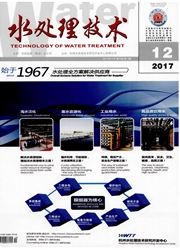

 中文摘要:
中文摘要:
采用锰氧化细菌生成的生物氧化锰为氧化剂,以化学氧化锰为对照,研究其对17β-雌二醇(E2)氧化降解的反应动力学,考察相关因素(如pH、氧化锰投加量等)对氧化降解的影响。结果表明,E2对生物氧化锰的氧化作用有较强的反应感受性,其被生物氧化锰降解的效果要优于化学氧化锰;在pH7.0,E2与氧化锰的投加比为1:10条件下,60h时E2被生物氧化锰和化学氧化锰分别降解了69.7%和39.3%,且两种反应体系均表现为复杂的反应动力学,对其4h的反应进行1级动力学拟合,得到相关性系数分别为0.895和0.935;通过相关影响因素的研究,发现生物氧化锰对E2的氧化降解速率与氧化锰的投加量呈正相关,与pH呈负相关;此外,生物氧化锰反应体系中的雌激素总体活性降低更为明显,反应过程中检测到了1个主要产物为雌酮(E1)。
 英文摘要:
英文摘要:
The biogenic manganese oxides, which was produced by the mixture of manganese oxidizing bacteria, were investigated to remove 17β-estradiol (E2) in batch experiments, and 8-MnO2 was used as the comparison. The influence ofpH and manganese oxides dosage on the reaction kinetics were discussed. Results showed that during the process, E2 had a stronger reaction sensitivity on biogenic manganese oxides, and in which the removal efficiency was higher than that in chemical MnO2. At pH 7.0, when c(E2):c(manganese oxides)=1:10, a high removal efficiency (69.7%) was obtained with biogenic manganese oxides after 60 h, compared with a low removal efficiency (39.3%) of S-MnO2, and the two reactions followed the complex reaction kinetics. While, the relative coefficient was 0.895 for the biogenic manganese method and 0.935 for 8-MnO2 method by linear fitting the kinetics of E2 for 4 h reaction using pseudo-first-order model. Biogenic manganese oxides dosage had a positive effect on oxidative transformation of E2, and initial reaction rate increased as pH decreasing. In addition, estrogenic activity could be reduced by biogenic manganese oxides more rapidly and one product of estrone (El) was detected by gas chromatography coupled with mass spectrometry (GC-MS).
 同期刊论文项目
同期刊论文项目
 同项目期刊论文
同项目期刊论文
 期刊信息
期刊信息
